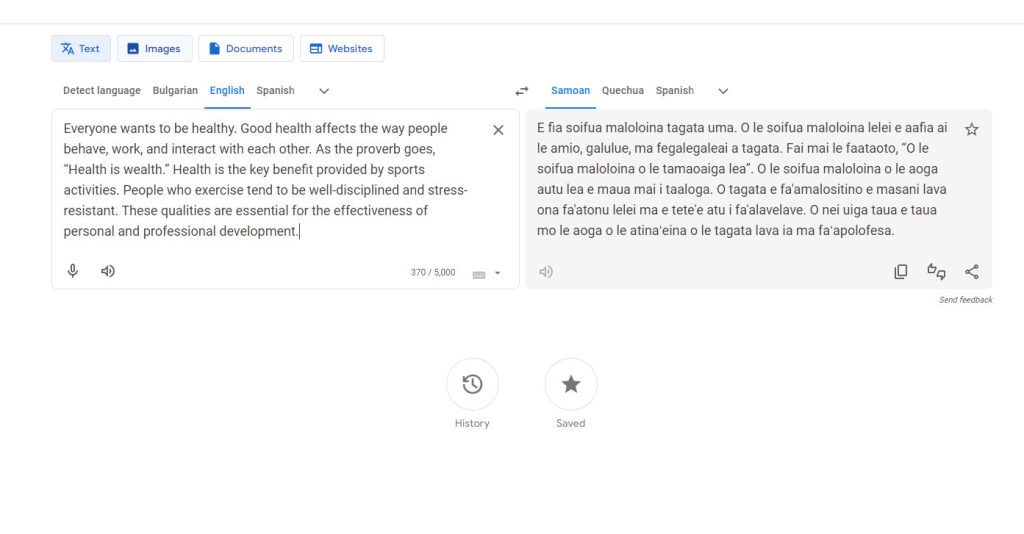Document translation from Spanish to English plays a pivotal role in international communication and business relations. English is one of the most widely spoken and used languages globally. According to statistics, approximately 1.5 billion people speak English as either a native or second language. It is recognized as the official language in more than 50 countries, as well as in international organizations, business, and the internet.
On the other hand, Spanish also holds a significant place in the world's linguistic landscape. With over 580 million speakers worldwide, Spanish ranks second in terms of the number of speakers after Chinese. Spanish is the official language in 20 countries and exerts significant influence on the world of culture, literature, art, and business relations.
 Finally, the most crucial aspect for me is optimizing the workflow. I prioritize tasks: it's not always possible to translate the entire text at once in the order it is presented. Therefore, right at the beginning, when I divide it into fragments, I establish the order and determine the approximate time for each segment. Tools like Trello and Google Keep help me adhere to the set deadlines.
Finally, the most crucial aspect for me is optimizing the workflow. I prioritize tasks: it's not always possible to translate the entire text at once in the order it is presented. Therefore, right at the beginning, when I divide it into fragments, I establish the order and determine the approximate time for each segment. Tools like Trello and Google Keep help me adhere to the set deadlines.

The Importance of Translation from Spanish to English
Considering these numbers, it becomes clear that translating documents from Spanish to English allows for audience expansion, improved access to information, facilitation of business transactions, and cultural exchange. It's essential to note that the accuracy and quality of translation are crucial in the context of international relations and business communications. Therefore, opting for qualified translators or utilizing modern translation technologies becomes necessary for successful communication and interaction on the international stage.When Speed Matters
Fast document translation from Spanish can be necessary both in personal and business contexts. Here are several typical scenarios where translation speed is particularly important:- Legal Transactions. In the legal field, situations often arise where quick contract execution, agreement signing, or other legal procedures are required. Prompt document translation allows parties to buy and sell real estate faster, conclude contracts, execute powers of attorney, etc.
- Medical Urgencies. Speed is especially crucial in healthcare when, for example, an urgent operation needs to be performed, but translated consent from relatives, medical records, or opinions from other doctors are required. Quick response helps doctors make informed decisions about diagnosis and treatment.
- Business Negotiations. In the business sphere, urgency is often associated with the need for prompt response to customer inquiries, providing "hot" offers, or participating in negotiations when there is no time for deliberation regarding signing one contract or another.
- Journalism. Reporters often work live, requiring rapid processing of available facts. In such cases, translation of various reports, financial documents, market research may be needed.
- International Conferences and Events. This applies to both business and scientific events: conferences, round tables, practical seminars. In this case, various reports, maps, drawings, schemes, and annotations may need translation.
Is Faster Translation Possible?
To expedite translation, it's better to have electronic versions of documents on hand to avoid manually typing various fragments. Therefore, I always scan all texts beforehand if I don't have them in Word format. I recommend converting other formats to Word for ease of copying information. My step-by-step plan looks like this:- Document Preparation. Before starting the translation, I always ensure that the documents are well-structured and organized. If I come across any complex terms or specialized vocabulary, I familiarize myself with them in advance.
- Text Division. If the document is extensive, I divide it into smaller parts and translate them sequentially. This helps me avoid information overload and enhances focus on each individual segment.
- Use of Ready-Made Templates and Phrases: When translating typical documents such as letters, reports, or presentations, I use ready-made templates and standard English phrases. This helps me save time and ensures stylistic consistency.
- Self-Checking and Editing. After completing the translation, I go through the text to check for errors and inaccuracies. I also utilize Word tools, such as enabling grammar check in the editor. For novices, I recommend using specialized services like Grammarly.
- Additional Editing: When working with technical terms, it's always logical to involve relevant specialists to review the translation. For example, when I take on documents about the operation of household appliances, I turn to appropriate services for assistance.
 Finally, the most crucial aspect for me is optimizing the workflow. I prioritize tasks: it's not always possible to translate the entire text at once in the order it is presented. Therefore, right at the beginning, when I divide it into fragments, I establish the order and determine the approximate time for each segment. Tools like Trello and Google Keep help me adhere to the set deadlines.
Finally, the most crucial aspect for me is optimizing the workflow. I prioritize tasks: it's not always possible to translate the entire text at once in the order it is presented. Therefore, right at the beginning, when I divide it into fragments, I establish the order and determine the approximate time for each segment. Tools like Trello and Google Keep help me adhere to the set deadlines.
Prospects of Artificial Intelligence Utilization
Artificial intelligence (AI) is becoming an increasingly vital tool in the field of translation. Machine translation systems offer fast and accurate results, making the process more efficient and accessible to a wide range of users.Swift Problem Solving – Vidby.com
The online AI translation service Vidby.com allows you to upload a document in Spanish and receive a quality translation into English almost instantly. It supports formats such as DOCX, PDF, TXT, and others. Vidby.com works with various document themes, from technical to legal. The quality of the result is high due to the ability to involve linguists, although it is also influenced by the quality of the source file.The Trusted Old Method – Google Translate
While Google Translate provides fast translations, I don't use it in a professional capacity. The system doesn't always grasp language nuances and often makes errors, especially when dealing with technical texts or complex terms. A document translated with Google Translate is unlikely to pass certification. However, if an apostille isn't required and the final text is only needed for personal use, its quality is sufficient. By the way, this tool recognizes images, so there's no need for additional programs to convert material into text.
